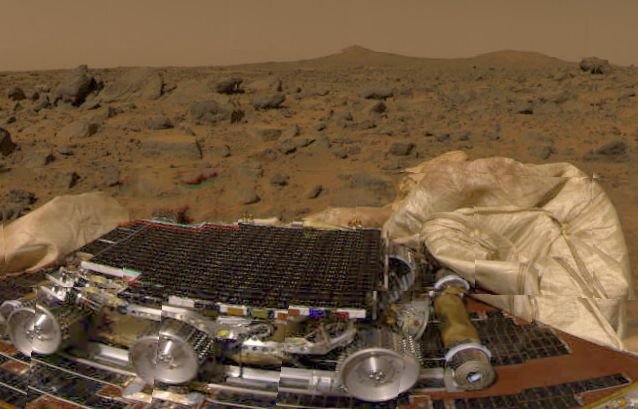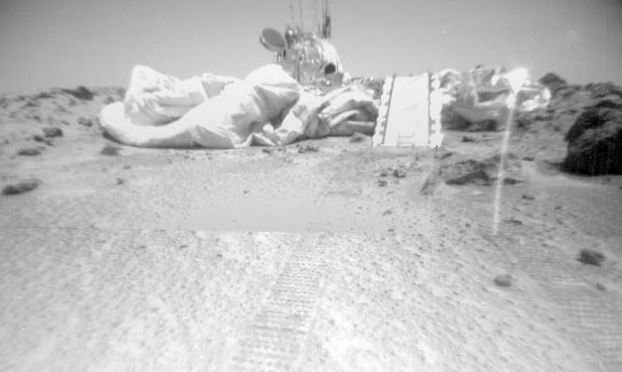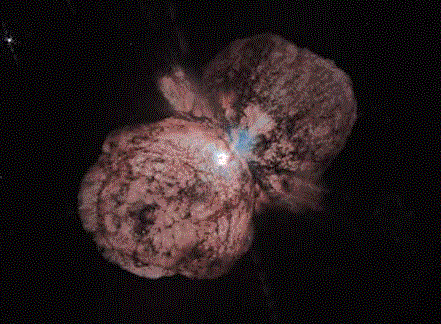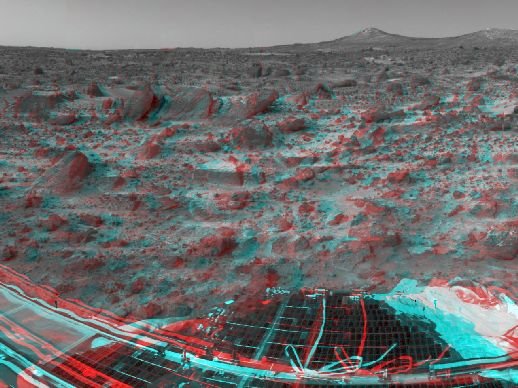NASA APOD #747-756
#747 Pathfinder on Mars July 05, 1997
“Yesterday, July 4th, using its own array of fireworks, a parachute, and a cocoon of airbags, the Mars Pathfinder spacecraft successfully bounced and came to rest on the surface of Mars at 10:07 AM Pacific Daylight Time. And the news is wonderful - the spacecraft appears to be in good health after having performed its complicated landing sequence superbly. Above is a mosaic of images from the martian surface transmitted shortly after Pathfinder reestablished communication with its mission operators on Earth. The solar powered, two foot long, 25 pound Mars Sojourner robot rover is visible crouched on the unfolded spacecraft. Surrounding Pathfinder are deflated airbags and a rock-strewn terrain. In the distance martian hills appear against a dusty brownish sky. The IMP camera which produced this view is also capable of stereo images and promises further spectacular pictures from Mars."
Copyright: Public domain
#748 A Martian Day's End July 06, 1997
“A Day or "Sol" on Mars is only 40 minutes longer than an Earth day - and Pathfinder's first day on Mars, Sol 1 according to its local calendar, was an eventful one. Still, late in the martian afternoon of Sol 1, the camera on board the Mars Pathfinder spacecraft recorded this panorama of the ancient floodplain Ares Vallis. Two of the three landing petals lie in the foreground at the edges of this scene surrounded by deflated and partially gathered airbags. The martian soil near the spacecraft has been disturbed by the airbag retraction. The petal holding the undeployed robot rover Sojourner is at the left. One of Sojourner's planned routes to the surface will be down the ramp seen rolled up at the petal's edge. Mission teams have overcome some rover communications problems and are proceding carefully with plans to roll the Sojourner out onto the martian surface. NASA has announced that the Pathfinder station on Mars will be renamed in honor of astronomer Carl Sagan."
Copyright: Public domain
#749 Sojourner On Mars July 07, 1997
“The six wheeled robot rover Mars Sojourner rolled onto the martian surface on July 5th (Sol 2) at about 10:40 PM Pacific Daylight Time. This image confirms that its descent down the lander's rear deployment ramp was successful. Click on the image to download a "movie gif" constructed from 9 images taken by the Sagan Memorial Station's IMP camera which shows the rover rolling down the ramp! The rover moved only a short distance from the ramp and spent the night analyzing the martian soil with its Alpha Proton X-Ray Spectrometer. Its next destination will be a tantalizing rock about 1 foot away that scientists have named "Barnacle Bill". A slow but steady off-road vehicle powered by a 1.9 square foot solar array, the rover can negotiate obstacles tilted at a 45 degree angle and travels at less than half an inch per second or nearly 0.03 miles per hour."
Copyright: Public domain
#750 Barnacle Bill And Sojourner July 08, 1997
“Deployed on a pop-up mast to its full height, the Sagan Memorial Station's IMP camera now stands about 5 feet above the surface of Ares Vallis - on Mars. This is one of the first images from its new vantage point, showing the rover Sojourner near a rock named Barnacle Bill. This particularly interesting rock, with a variety of surface textures, appears to be about 8 to 10 inches high. Sojourner performed an analysis of Barnacle Bill by successfuly maneuvering to place its Alpha Proton X-Ray Spectrometer (APXS) instrument against the rock. The APXS, located at the rear of the rover, is not visible in this picture. Sojourner's next destination is ... a rock named Yogi. Results describing the composition of Barnacle Bill, the martian soil and a color panorama of the landing site will be presented at a Pathfinder press briefing today scheduled for 11:00 AM Pacific Daylight Time."
Copyright: Public domain
#751 Sol 4: Mars Color Panorama July 09, 1997
“These mosaicked images form a color panorama of the region immediately surrounding the Sagan Memorial Station on Mars. The most recent images were recorded on Sol 4 - the 4th day of operations on the martian surface. The composite view reveals the reddish soil and rock-strewn terrain of an ancient martian flood channel. At top panel left the unused forward rover deployment ramp is seen extending from the bottom of the frame while farther to the right the Sojourner rover is visible. The large dark looking rock at the top of the panel near the right-hand side is called "Yogi". The now famous martian rock, Barnacle Bill, is seen just to the left of the rover itself. Sojourner's analysis shows that Barnacle Bill is unexpectedly similar to common quartz containing volcanic rocks on Earth! In the bottom panel yellowish material from some of the airbags that were used during landing can be seen along with regions of the martian soil that have been disturbed by the retraction of the deflated airbags."
Copyright: Public domain
#752 Sojourner's View: The Sagan Memorial Station July 10, 1997
“The robot rover Sojourner sees Mars from the perspective of a house cat. During the 7 month cruise to Mars aboard the Pathfinder spacecraft, Sojourner measured only seven inches tall in a stowed position but prowling the martian landscape it has stretched to its full height of 1 foot (30 centimeters). In this mosaic of images Sojourner's cameras look back on its mother ship, now the Sagan Memorial Station, which seems to loom above it. The deployment ramp is visible along with deflated airbags, instrumentation masts and tracks left in the martian soil by the robot's six cleated 5-inch aluminum wheels. So far the rover has been directed to analyze soil and the composition of two rocks, Barnacle Bill (seen just to the right of the ramp) and Yogi. Human operators select Sojourner's targets but the robot rover is relied on to navigate to its destination autonomously. Click here to download a movie gif of Sojourner creeping toward Yogi."
Copyright: Public domain
#753 Yogi Rock July 11, 1997
“This portrait of Yogi Rock, a now famous boulder on Mars, was recorded on Sol 3 by the Imager for Mars Pathfinder (IMP). Big and friendly looking like its Earth cartoon namesake Yogi Bear, Yogi Rock is a prominent visible feature at the Pathfinder landing site. Yogi and surrounding soil are being examined close up by the Sojourner robot rover. Initial attempts to approach the rock and to place Sojourner's Alpha Proton X-ray Spectrometer against it have met with some minor, but not unusual, difficulties. It is speculated that the light colored "moat-like" terrain around Yogi is the result of the evaporation of surface water deposited by ancient floods."
Copyright: Public domain
#754 Doomed Star Eta Carinae July 12, 1997
“Carinae may be about to explode. But no one knows when - it may be next year, it may be one million years from now. Eta Carinae's mass - about 100 times greater than our Sun - make it an excellent candidate for a full blown supernova. Historical records do show that about 150 years ago Eta Carinae underwent an unusual outburst that made it one of the brightest stars in the southern sky. Eta Carinae, in the Keyhole Nebula, is the only star currently thought to emit natural LASER light. This image, taken last September, resulted from sophisticated image-processing procedures designed to bring out new details in the unusual nebula that surrounds this rogue star. Now clearly visible are two distinct lobes, a hot central region, and strange radial streaks. The lobes are filled with lanes of gas and dust which absorb the blue and ultraviolet light emitted near the center. The streaks remain unexplained. Will these clues tell us how the nebula was formed? Will they better indicate when Eta Carinae will explode?"
Copyright: Public domain
#755 Vela Supernova Remnant in Optical July 13, 1997
“About 11,000 years ago a star in the constellation of Vela exploded. This bright supernova may have been visible to the first human farmers. Today the Vela supernova remnant marks the position of a relatively close and recent explosion in our Galaxy. A roughly spherical, expanding shock wave is visible in X-rays. In the above optical photograph, the upper left corner of the spherical blast wave is shown in detail. As gas flies away from the detonated star, it reacts with the interstellar medium, knocking away closely held electrons from even heavy elements. When the electrons recombine with these atoms, light in many different colors and energy bands is produced."
Copyright:
Anglo-Australian Telescope Board
#756 Mars: Twin Peaks In Stereo July 14, 1997
“Get out your red/blue glasses and gaze across the surface of Mars in stereo. You are looking south of west across an ancient flood channel, Ares Vallis, landing site of the Mars Pathfinder. A rover deployment ramp and lander petal define the foreground in this 3D-view while a field of rocks seems to stretch to the horizon. At the upper right, over half a mile distant, are the hills known as the "Twin Peaks". Today is Sol 10, the tenth day the Pathfinder lander and Sojourner rover have been operating on the martian surface. Over that period, the mission has been returning a wealth of images and data. The otherwise successful rover activities have been recently hampered by some communication and computer difficulties."
Copyright: Public domain
Upvote! Resteem! Comment! As you like it! Thank you for attention!










Resteemed to over 5900 followers and 100% upvoted. Thank you for using my service!
Send 0.100 Steem or 0.100 Steem Dollar and the URL in the memo to use the bot.
Read here how the bot from Berlin works.
@resteem.bot